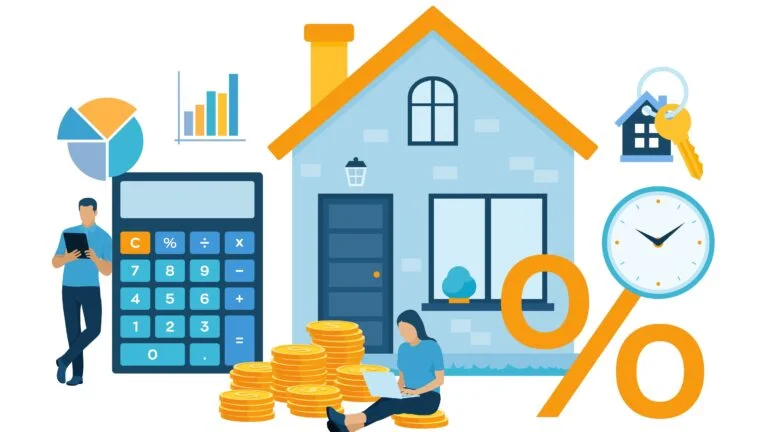The property market is in a constant state of evolution, and one of the biggest factors influencing it is interest rates. As we’ve witnessed recently, fluctuations in interest rates can either cool the market or ignite a buying frenzy. So, what does this mean for you as an investor? How do these shifts in rates affect your ability to build wealth through property?
The Link Between Interest Rates and Inflation
Interest rates are the government’s primary tool for controlling inflation. When inflation rates rise, the cost of living increases—affecting everything from groceries to fuel—and consumers often tighten their budgets. While high inflation can sometimes push property prices up, it generally leads to decreased spending power for individuals and households.
To combat inflation, central banks, such as the Reserve Bank of Australia, may raise interest rates. Higher interest rates mean that borrowing money becomes more expensive, which slows down consumer spending on big-ticket items, including property. The ultimate goal of this strategy is to keep inflation in check and prevent the economy from overheating.
How Interest Rates Affect Borrowing Power
When interest rates rise, your borrowing power decreases. This is due to the fact that higher interest rates lead to higher monthly repayments, causing lenders to assess your borrowing capacity based on your ability to meet these costs. For many buyers, this means that they cannot borrow as much as they could in a low-interest-rate environment, reducing their competitive edge in the market.
Conversely, when interest rates drop, borrowing becomes cheaper, resulting in increased buyer competition. More people find themselves able to secure loans, and as demand increases, property prices often begin to rise. Historically, we have seen property markets heat up significantly after interest rate cuts, with both investors and homebuyers flooding into the market to take advantage of the lower borrowing costs.
The Boom That Follows Rate Cuts
When interest rates decline, the market tends to experience a surge in activity. More buyers can afford larger loans, and as demand escalates, property prices often soar. Buyers who were previously priced out of the market start to re-enter, and those on the sidelines rush to buy before prices climb too high. This creates a snowball effect that can rapidly drive up property values in growth markets.
However, here’s the key takeaway: waiting for rates to drop might mean missing out. Even now, with higher interest rates, property prices in some areas continue to rise. There are always markets within markets—while some areas may cool down, others are seeing exceptional growth. This highlights the importance of looking at data-driven insights and short-term pressure indicators.
What to Focus On: Short-Term Indicators
By focusing on short-term indicators, you can identify growth markets that are positioned for future appreciation:
- Low Days on Market: A lower average suggests strong buyer interest and indicates properties are selling quickly, reflecting robust demand. Pre-approval can speed up your buying process when opportunities move fast.
- Balanced Inventory Levels: A healthy inventory level means there is enough supply to meet current demand without oversaturating the market. This balance is crucial for maintaining stable property growth. To avoid overpaying in competitive markets, understanding bank valuations is a smart move.
- Average Vendor Discounting: Monitoring how much sellers are willing to negotiate helps gauge market competitiveness. Generally, lower discounts indicate a stronger market. If you’re unsure how to proceed, negotiation strategies can make a big difference.
- Buyer Engagement Metrics: Keep an eye on the number of people viewing properties online and attending open homes. High engagement levels indicate robust interest in the area. Before jumping in, make sure you’ve performed due diligence to avoid unexpected surprises..
When interest rates eventually drop, properties in these well-positioned markets may experience significant value increases. Waiting too long could mean missing out on current opportunities, as many growth areas are already experiencing price increases despite higher rates. This is particularly true in markets that demonstrate a balance of healthy demand and appropriate supply levels, which are essential for stable property growth.
Strategic Timing in Growth Markets
While it is beneficial to enter the property market early, it’s critical to base your timing on clear data and market trends. Acting quickly without thorough analysis may lead to investing in a market that underperforms. Focus on solid statistics—such as low days on market and balanced inventory levels—that signify genuine growth opportunities.
Investing in a growth market requires diligence. Conduct thorough research and monitor key metrics revealing underlying patterns. These insights will help you identify markets poised for appreciation. Short-term pressures like low days on market and healthy inventory levels signal strong buyer interest and demand, creating a favorable environment for investment.
By strategically entering promising markets now, you position yourself to take advantage of future growth—especially when interest rates decline. Waiting too long could mean missing significant opportunities and rising prices in markets that are already showing signs of upward momentum.
Interest rates play a crucial role in the property market, influencing everything from inflation to borrowing capacity. While high interest rates might cool the market currently, they also present opportunities for those who can navigate short-term pressures and growth indicators. When rates inevitably drop, we are likely to see the market heat up quickly. Don’t wait for that moment—by then, the best deals could be gone.
Investing in property is all about timing and strategy, and with the right approach, you can seize opportunities today that will set you up for long-term success.
4.Is Interstate Property Investing Right for You? Pros and Cons Explored!
Investing in property interstate can be an exciting opportunity, allowing you to tap into high-growth markets and diversify your portfolio. However, like any investment strategy, it comes with its own set of advantages and challenges that every investor should carefully consider. Understanding these pros and cons is crucial to determining whether interstate investing aligns with your financial goals and management style.
In this email, we’ll explore the key benefits, such as access to more lucrative markets and the ability to leverage local property management, as well as potential drawbacks like reduced hands-on control and the complexities of navigating unfamiliar regulations. By weighing these factors, you can make an informed decision that sets you on the path to successful property investment.
Pros:
- Access to High-Growth Markets
Expand your reach to regions with stronger growth potential for better returns. - Diversification
Spread risk across different economies, reducing the impact of downturns in one area. - Leverage Local Property Managers
Professional managers handle everything from tenants to maintenance, so you don’t have to. - Tech-Driven Convenience
Video inspections, digital updates, and remote management tools make investing from afar easy. - Higher Rental Yields
Some interstate markets offer better rental yields, boosting cash flow. - Economic Diversity
Invest in regions with different economic drivers, benefiting from various growth factors. - Better Affordability
Interstate markets often offer lower property prices compared to your local area, increasing accessibility. - Scalability
Easier to grow your portfolio by spreading investments across multiple markets.
Cons:
- Less Hands-On Control
Being distant limits your ability to personally oversee the property. - Knowledge Gaps
Relying on professionals means you might miss local market nuances. - Property Manager Limitations
They can’t handle structural issues or major renovations—additional experts are needed. - Travel Costs
You may occasionally need to visit the property, adding to your expenses. - Regulatory Complexity
Each state has different legal requirements, which may complicate compliance. - Time Zone Differences
If managing from a distance, communication could be trickier due to time zone variances. - Market Volatility
Interstate markets may experience fluctuations you’re not prepared for. - Cultural and Local Differences
Local customs and tenant expectations can vary, impacting property management decisions. - Property Performance Monitoring
Less immediate oversight of rental yields and vacancy trends compared to local properties. - Trusting Local Teams
You’re relying heavily on the performance and honesty of local agents and managers.
Interstate property investing presents a unique set of opportunities and challenges that can significantly impact your investment strategy. By carefully weighing the pros and cons, you can make informed decisions that align with your financial goals. Whether it’s accessing high-growth markets or managing properties remotely through professional support, the right approach can lead to substantial rewards. If you have any questions or would like to discuss your options further, please don’t hesitate to reach out. I’m here to help you navigate the complexities of interstate investing and support your journey toward successful property ownership.




